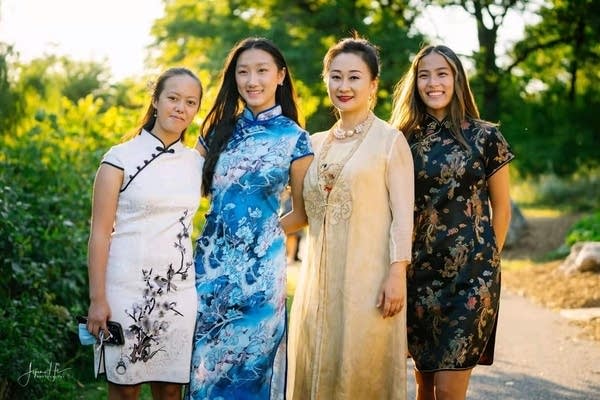Twin Cities Chinese dance academy reconnects Hmong refugee with childhood dreams

Go Deeper.
Create an account or log in to save stories.
Like this?
Thanks for liking this story! We have added it to a list of your favorite stories.
It took 16 years for Lee Sanhunchai to pursue her dream of Chinese dance.
The dream was born in a Hmong refugee camp deep in the jungles of northern Thailand when she was 10. One weekend she snuck over to her neighbor’s house to watch “Butterfly Lovers,” a 1994 film that featured a Chinese classical music piece commonly performed in China.
Captivated by the sounds of the Chinese drum, harp, violin and flute, Sanhunchai decided at that moment she wanted to dance.
“I felt like my soul has been dancing before I even started to dance,” she said. “Especially with Chinese classical music. It sounds so peaceful and beautiful at the same time.”
Turn Up Your Support
MPR News helps you turn down the noise and build shared understanding. Turn up your support for this public resource and keep trusted journalism accessible to all.
After moving to the U.S. at the age of 15, she struggled with culture shock. Moving from North Carolina to Seattle to secure financial stability prevented her from making meaningful friendships or finding the time to dance.
That changed two years ago when Sanhunchai, who had no experience in dance, moved to St. Paul and started dancing. Now 34, she has found a “family” at Phoenix Chinese Dance Academy, a Chinese dance school based in the Twin Cities.
“When I joined Phoenix they were very positive and encouraging,” she said. “They create this environment where you feel safe to express your true self and to show your ability in dancing.”

For Chinese adoptee, Phoenix is about finding identity
The dance academy was founded by Ying Li, who is originally from the northern coastal city of Dalian. Li spent a decade teaching at CAAM Chinese Dance Theater in St. Paul before founding her own dance school in 2019.
“Some people prefer to eat Americanized Chinese food, while others like authentic Chinese food,” said Li. “My philosophy of running the school is to dance pure Chinese dance, so that the audience can experience the splendor of Chinese culture in the taste of China.”
Since 2019, Phoenix has grown from 40 to about 80 female dancers, ranging from preschoolers to adults in their 60s.
“In Chinese there’s a word for everybody, they call it ‘dàjiā’,” said Sanhunchai. “It means ‘one big family’ and so that’s how I feel with Phoenix.”
Li, better known to her students as Li Lǎoshī or Teacher Li, teaches dance in Mandarin and English. The immersion into Chinese culture is especially important to 16-year-old Charlotte Emanoff, an adoptee from Hunan, China.
Emanoff is a senior dancer at Phoenix and has been dancing under Li since she was about four years old. Her white parents wanted her to be involved in something that would keep her connected to her cultural roots so they enrolled her in Chinese dance classes, and Emanoff has loved it ever since.
“Culture is a very big part of our identity,” she said. “So when that part’s missing, you kind of don’t know who you are. So I think for me, it just was kind of about finding myself and then learning more about my culture, traditions and food.”
She hopes to continue Chinese dance in college or at a local school after she graduates high school.

Chinese dance school brings community to young Asian women
Fellow dancer Annie Bai, who has been training in Chinese dance for seven years, has seen significant growth in herself since joining Phoenix. Bai said she appreciates Li’s teaching style, which caters to each dancer's unique strengths.
“I pretty much never even dreamed of ever getting a solo” while dancing in other companies, Bai said.
Under Li, Bai has had opportunities to do solo performances and explore dance styles from different regions of China. And as a Chinese Minnesotan, she values being a part of an Asian community at Phoenix.
“Especially in Minnesota, it’s not that common to be able to be in an environment where you’re surrounded by people with a similar background to you,” said Bai. “Aside from speaking the language at home, I don’t really have that many other opportunities outside of home to explore more about that. Ever since joining Chinese dance I’ve been able to find myself in a group of people who are also looking for the same thing as me.”
For other dancers like Sanhunchai, Phoenix has been welcoming to people who don’t have any experience in Chinese dance. Since joining Phoenix in 2021, Sanhunchai has learned how to count beats and utilize her flexibility in performances.
Most importantly, she feels she is the same 10-year-old girl in the Hmong refugee camp that always dreamed of dancing.
“It's almost like I'm bringing that inner child joy back to my life again,” she said.

Dear reader,
Political debates with family or friends can get heated. But what if there was a way to handle them better?
You can learn how to have civil political conversations with our new e-book!
Download our free e-book, Talking Sense: Have Hard Political Conversations, Better, and learn how to talk without the tension.




